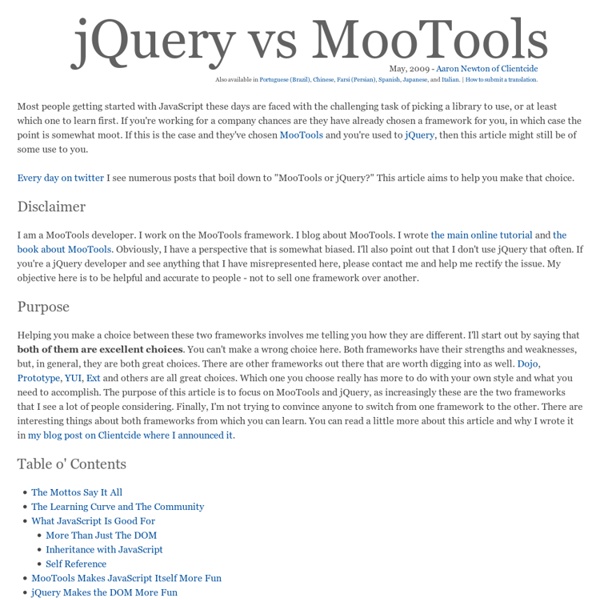



Image Reflection with jQuery and MooTools One subtle detail that can make a big difference on any web design is the use of image reflections. Using them too often can become obnoxious but using reflections on large, "masthead" images is a classy enhancement. Unfortunately creating image reflections within your graphics application can be time-consuming, especially when an image can potentially change frequently. Reflection.js is a JavaScript utility available in both jQuery and MooTools that creates reflections for any images in a page. The HTML Add the reflect CSS class to any image you'd like to reflect. The MooTools JavaScript Usage The MooTools version of Reflection.js implements the reflect method to create reflections. The jQuery JavaScript Usage Much like MooTools method, you execute each element's reflect method. Christophe's Reflection.js code is a great piece of work! Be Heard Tip: Wrap your code in <pre> tags or link to a GitHub Gist! Older Introducing MooTools ScrollSide Newer Create PHP Classes with Dynamic Functions
Bumpbox - A Lightbox Clone that Supports PDFs Bumpbox is another lightbox clone with a few advantages over other lightboxes – it supports not only all common media types but also PDF’s. Yet, the integration and implementation on your own site is pretty simple. Just add the scripts to your head section, add classes to your links that should use bumpbox, define a rel tag with the size that the bumpbox should have and you’re ready to roll. Bumpbox automatically detects what kind of filetype you wish to show in the box, so you do not need to specify the type, easing the process of integration. Requirements: Mootools Framework 1.2 Demo: License: License Free FancyUpload Previous Version If you missed the link above, the previous FancyUpload for MooTools 1.11 is still available including example code and minor updates. It is not maintained anymore. Features Compatibility Fully compatible with all A-Grade Browsers (Internet Explorer 6+, Opera 9, Firefox 1.5+ and Safari 3+) with Adobe Flash 9 and 10 player. How to use The available showcases show off documented code snippets with various use cases. Documentation Class: Swiff.Uploader Extends: Swiff Syntax: var uploader = new Swiff.Uploader([options]); Arguments: options - (object, optional) See options below. Returns: (object|false) - New Swiff.Uploader instance. Options: The options url, method, data and mergeData are also available in Swiff.Uploader.File. Events: load - (function) Function to execute when the Flash movie is initialised.fail - (function) Function to execute when the loading is prevented. Every Event starting with file is also called on the Swiff.Uploader.File class, without prepended file. Requirements
MooTools Plugin For Geolocation Tasks: MooGeo MooGeo is a MooTools plugin that makes accomplishing common geolocation tasks easy. These tasks include getting detailed info about an IP (country, city, longitude, latitude, etc.), parsing geographical data from text and even finding Flickr photos about a given place. The plugin makes use of multiple free-to-use services like: Yahoo PlaceMakerYahoo GeoPlanetjsonip.appspot.comW3C Geo locationFlickr.places.findLatLon and wraps them into a single package. MooGeo has also support for events on every level (when a request is sent, completed, success or error) which helps offering a better experience to end users. Add More Power To MooTools – PowerTools PowerTools is a set of MooTools plugins that are created by Christoph Pojer (MooTools Core Developer). There are 20+ plugins provided where each of them can be downloaded one-by-one or you can select the ones needed and get a package. The plugins include touch, mouse, swipe, click event replacements for mobile browsers, auto-grow for forms, history support for Ajax apps and much more. Every item is well documented and linked to their repositories for the downloads and comes with demos.